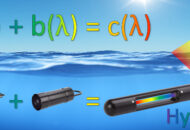In 2024, Sequoia was funded under a NASA SBIR Phase I grant to develop a submersible hyperspectral transmissometer (Hyper-c) in support of ocean color and biogeochemistry research. The sensor complements our other hyperspectral absorption (Hyper-a) and backscattering (Hyper-bb) sensors, which were also developed under the NASA SBIR program.
Hyper-c (NASA SBIR Phase I)
More Info
Motivation:
In-situ sensors for measuring inherent optical properties (IOPs) of the water are critical to NASA’s (and other agencies) ship and airborne science campaigns, as these measurements provide critical information for refining and validating ocean color data products from remote sensing satellites. As satellite missions transition from multispectral to hyperspectral measurement capabilities, as evidenced by the launch of PACE in February 2024 and planned launches of GLIMR and SBG in the coming years, in-situ IOP sensors must similarly transition to match (or exceed) the wavelength range and resolution of these satellites without sacrificing accuracy. Through NASA SBIR funding in recent years, we have developed hyperspectral absorption (Hyper-a) and backscattering (Hyper-bb) instruments to address the need for improved capabilities of in-situ IOP sensors. To complement these sensors and continue progress towards full hyperspectral IOP closure, we proposed to develop a hyperspectral transmissometer (Hyper-c) for measuring transmission and beam attenuation (another critical IOP).
Summary:
The 6-month Phase I project began in August 2024 and concluded in February 2025. Over the course of the project, we designed, assembled, and tested a sensor breadboard in the lab, successfully demonstrating hyperspectral beam attenuation measurements on samples of interest. We benchmarked these measurements against a commercial spectrophotometer which showed good agreement with the measurements from our breadboard. In addition, we demonstrated the sensor could be modified to measure complementary inelastic scattering phenomena that enhance the scientific output of the sensor.
The project brought the Hyper-c to a Technology Readiness Level (TRL) of 4. We plan to continue developing the sensor to TRL 9 (e.g., commercial) in the coming years to add to our suite of sensors for hyperspectral IOP measurements.
Relevant Links:
Sequoia Press Release: Sequoia funded by NASA for developing hyperspectral transmissometer!
NASA SBIR Phase I Selections: 2024 SBIR/STTR Phase I Selections
Sponsor
This project was funded through NASA’s Small Business Innovation Research (SBIR) program under contract #80NSSC24PB439. To learn more about the program, click here: NASA’s SBIR Program
Updates
Phase I was concluded 02/06/2025.Accessories
N/A
